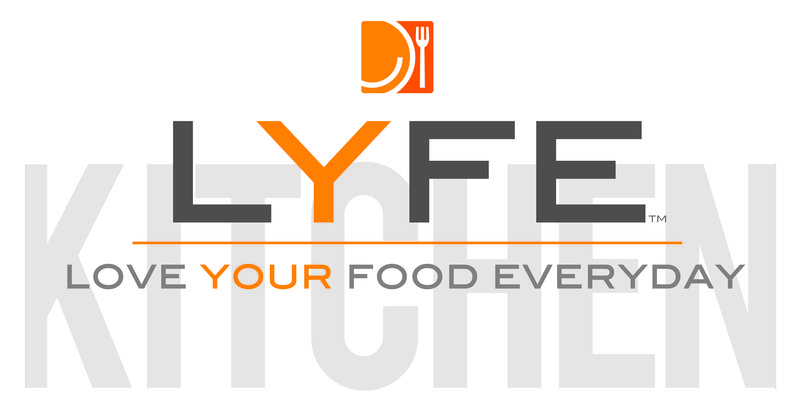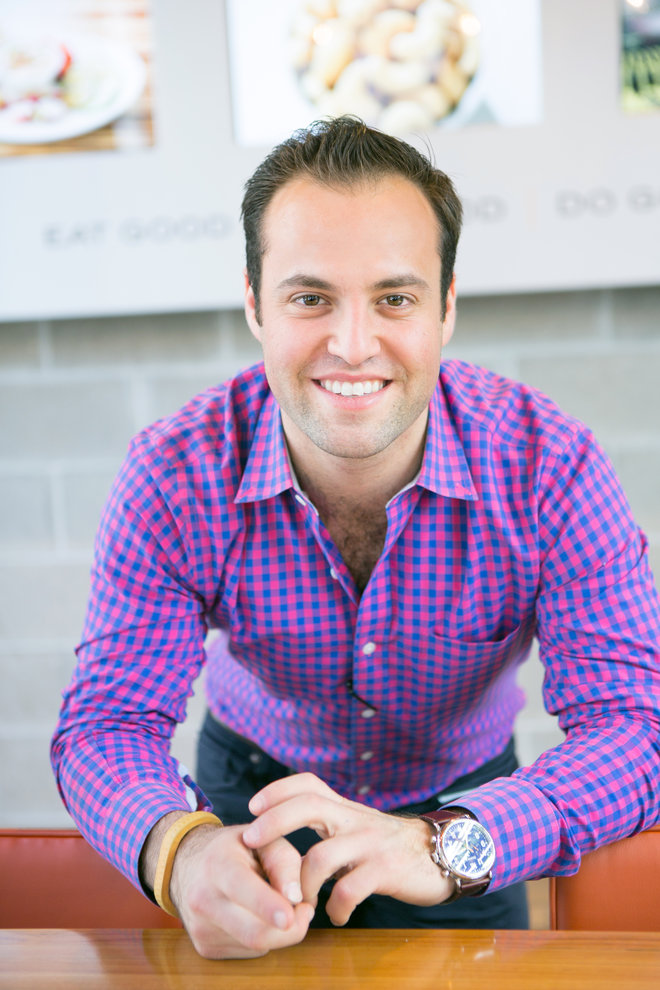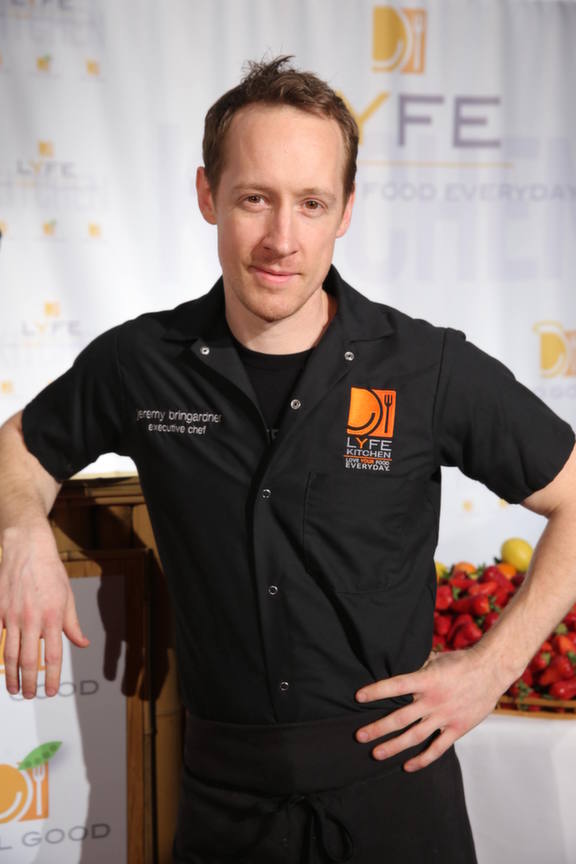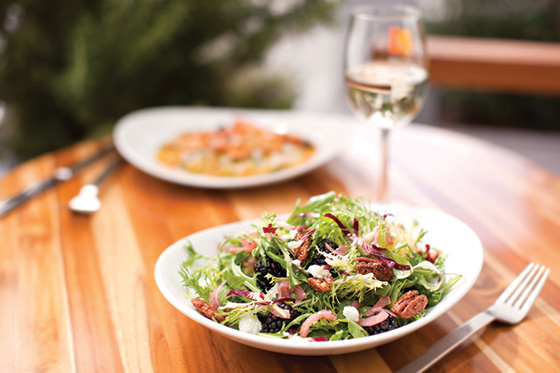| « Your Perfect, Beer-Filled Weekend | Friday Foodpic: Le's Pho » |
Interview Mon Oct 13 2014
The LYFE Story: A Conversation with Nate Cooper & Jeremy Bringardner
 I first learned about LYFE ("Love Your Food Everyday") in March 2013, when I struck up a casual conversation with Jeremy Bringardner, fresh into his new role as corporate executive chef. He described LYFE as "an innovative healthy fast casual restaurant concept" and that they "just opened [their] second restaurant in Los Angeles (first one is in the bay area) and... have 248 more to go in the next five years." Though I admired his fervent optimism, I imagined all the heads of Chipotle and Cosi and Pret, giggling in their seats over sustainable salmon and chia-infused juices. Now almost a year and a half later, with 15 LYFE storefronts, I'm sure they're feeling the glowing embers of that bright-orange logo heating up underneath their seats.
I first learned about LYFE ("Love Your Food Everyday") in March 2013, when I struck up a casual conversation with Jeremy Bringardner, fresh into his new role as corporate executive chef. He described LYFE as "an innovative healthy fast casual restaurant concept" and that they "just opened [their] second restaurant in Los Angeles (first one is in the bay area) and... have 248 more to go in the next five years." Though I admired his fervent optimism, I imagined all the heads of Chipotle and Cosi and Pret, giggling in their seats over sustainable salmon and chia-infused juices. Now almost a year and a half later, with 15 LYFE storefronts, I'm sure they're feeling the glowing embers of that bright-orange logo heating up underneath their seats.
Though founded by two McDonald's executives, LYFE strays far from that sugar and fat-laden image. Their all-encompassing motto is "Great food can do amazing things. It can make you feel better. It can support local farms. Promote sustainability. Reward environmentally sound businesses. Give back to the community." And if one doesn't care about any of the aforementioned claims, then at least LYFE is relatively affordable for the type of premium quality it serves. Not that I can taste the sustainability or organic-ness, but LYFE food certainly tastes healthy. It's portioned according to normal, weight-maintaining standards, and overall, fairly light for the salt-accustomed palette. To compensate for the lack of butter, cream, and salt, the food relies heavily on acidity and spice to round out its dishes. Healthy food can shock a tongue accustomed to heavy flavors, but not everything is chia seeds and vegan quinoa wraps. Flatbreads, burgers, and "Art's Unfried Chicken" are as good as expected for less than 600 calories.
 Nate Cooper (co-founder, partner, and manager of LYFE Chicago) tells me that for less than $15, diners can eat a dish worthy of fine-dining standards. True, but a diner could easily go to Chipotle and order two burrito bowls for the same price, I respond. Nate tells me that it's not only about the food quality; it's also about the experience of sitting down and eating a home-style meal within a couple of minutes. Furthermore, you won't see Chipotle or Pret working with small-scale vendors like LYFE does. Still, it bewilders me that given its "sustainable, healthy, premium (and etc.)" dining pitch, LYFE makes profitable margins off its dishes. None of those characteristics have to be expensive, Nate tells me 600 calories is profitable. (And so are online menus, frozen food and catering.) It all comes down to economies of scale.
Nate Cooper (co-founder, partner, and manager of LYFE Chicago) tells me that for less than $15, diners can eat a dish worthy of fine-dining standards. True, but a diner could easily go to Chipotle and order two burrito bowls for the same price, I respond. Nate tells me that it's not only about the food quality; it's also about the experience of sitting down and eating a home-style meal within a couple of minutes. Furthermore, you won't see Chipotle or Pret working with small-scale vendors like LYFE does. Still, it bewilders me that given its "sustainable, healthy, premium (and etc.)" dining pitch, LYFE makes profitable margins off its dishes. None of those characteristics have to be expensive, Nate tells me 600 calories is profitable. (And so are online menus, frozen food and catering.) It all comes down to economies of scale.
Fortunately, I'm able to catch up with Jeremy later, and we chat briefly about his role at LYFE and plans for the future.
You went from Charlie Trotter's to executive chef of a healthy restaurant enterprise. What was that process?
After three years of blood, sweat and tears, and working in Charlie Trotter's intensely incredible kitchen, I needed a change of pace. Around that time, I met a single woman who was fighting colon cancer, and needed to radically change her eating habits to optimize her chances of beating it, but she didn't know how to cook. So, I became her personal chef! For the next six years, I juggled being a personal chef, food stylist, and managing catering opportunities. Just as I was beginning to miss working in restaurants, an opportunity fell on my lap, which was a chance to develop recipes on a consultant basis. The position came through a former colleague that I worked with at Charlie Trotter's (and who was working for chef Art Smith), who knew my rare skillset of having an extensive background in fine-dining cooking and also a degree in nutrition. This was the birth of the LYFE Kitchen menu.
 How did you land the position? What was that transition like?
How did you land the position? What was that transition like?
The transition was easy. It initially started as a side gig and eventually grew into a full-time consulting job. I fell in love with the vision of LYFE Kitchen, as it was the first time in my life that I had a chance to express myself through my three greatest passions: cooking, nutrition, and creativity. It was so exciting to be part of a team who aspired to change the world. About two years in, I packed up and moved to sunny California to become an official "LYFER."
How do you develop new recipes for the LYFE kitchen menu?
I meet regularly with our menu team, as we relentlessly pursue ways to improve the LYFE Kitchen menu. We study the numbers, look at Yelp reviews, keep an eye on industry trends and discuss menu needs and concepts. Ideas can come from anywhere at any time, so step one in my creative process is to capture those ideas on my phone. There's always a point where I check in with chef Art and chef Tal to flush out my ideas further. Also, I run them by our panel of doctors to see if there are any important medical/nutritional insights to consider. Necessary questions I ask myself when determining potential menu items includes: Is this recipe operationally viable? Are there any supply chain issues? Do we stock all the necessary ingredients? If not, how hard will it be to get the missing ingredients? What are the nutritional challenges? What is the LYFE twist? How does this concept fit into our existing menu?

What ingredients do you avoid using at LYFE?
At LYFE Kitchen, we don't believe in demonizing ingredients. Rather, we simply focus more on ingredients that are delicious and nutrient dense. We don't allow any artificial preservatives in our food and certainly do not add cream, butter or corn syrups. Recently, we added carrageenan to the list of ingredients that we don't allow, as our doctors panel advised us on recent findings that it can cause Leaky Gut Syndrome. When it comes to animal proteins, we focus on products that are humanely and sustainably raised. For beef, we prefer grass-fed for its nutritional qualities, but feature red meat only in limited quantities, due to its heavy carbon footprint. Also, we're currently taking at least a year off of adding shrimp to the menu, to give the struggling shrimp industry a chance to recover.
What's the culture like working for LYFE?
We are a very young company, so I think the culture is still being formed. One thing I love about our existing culture is the tenacity of our people. We all work together to challenge the status quo every day, and I think that's a very fulfilling way to live life. LYFE Kitchen isn't just a restaurant serving food, we're a group looking to provide America with great tasting, good for you foods that are affordable and convenient.
Are there any upcoming menu items that people should get excited about?
We have a silky, smooth cauliflower soup, served with freshly grated Parmesan cheese and chives that will be debuting this fall.
It's almost instinctual to associate American fast food with unhealthy food or cheap food loaded with sugar, fat, and preservatives. Conversely, "fancy" foods like fennel or salmon are only regularly consumed by rich suburbanites, or yoga-loving hippie types. But all demographics show interest in health-conscious eating, and LYFE occupies a very specific niche in that space, and frankly, it's a good position to be in. LYFE does its research thoroughly, and it implements quickly. The enterprise is young and nimble enough to adapt, yet financially robust enough to pursue lofty goals. Nate tells me that LYFE is going to change how Americans eat, and that Americans are ready for that change. Compared to a year and half ago, I believe that a lot more now.








